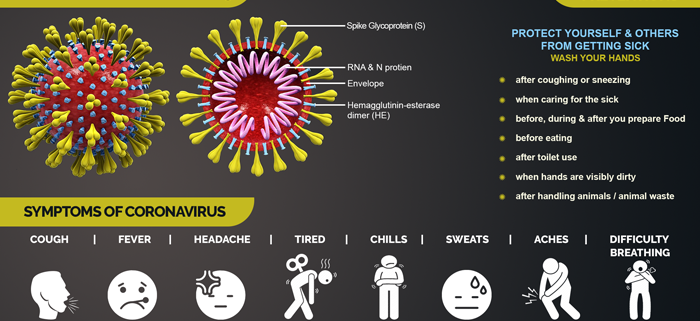What is Coronavirus? It’s Symptoms, Preventions and Statistics
In December 2019 there was a cluster of Pneumonia cases in China, investigations found that it was caused by a previously unknown virus now named the 2019 Novel Coronavirus. I will tell you all the possible information about this virus.
This is the new virus and what is known about the virus now, might change in the future. A coronavirus is a large group of viruses, they consist of the core of genetic material surrounded by an envelope with protein spikes. This gives the appearance of a crown. Crown in Latin is called Corona. And this is how the virus gets its name.
There are different types of coronaviruses that caused respiratory and sometimes gastrointestinal symptoms. Respiratory disease can range from the common cold to Pneumonia and in most people, the symptoms tend to be mild. However there are some types of coronaviruses that can cause severe disease, these include the Severe Acute Respiratory Syndrome (S.A.R.S) coronavirus.
That was first identified in China in 2013, and the Middle East respiratory Syndrome Coronavirus was first identified in Saudi Arabia in 2012. The 2019 Novel Coronavirus was first identified in China. It initially occurred in a group of people with Pneumonia, who had been associated with the seafood and the live animal market in the city of Wuhan, China. The disease has since spread from those who were sick to others including family members and health care staff. There are many cases at present, and the disease has spread within China and also to a number of other countries.
So, where did the virus come from, it’s known that the coronavirus circulates in the range of animals, sometimes these viruses can make the jump from animals to humans. This is called the spillovers and could be due to a range of factors, such as mutations in the virus or increase contact between humans and animals, from animals to humans. For instance, MERS-COV is known to be transmitted from camels and SARS-COV from cats. The animal raise of war 2019-NCOV is not known yet.
How is it Transmitted?
The exact dynamics of how the virus is transmitted is yet to be determined. In general, the respiratory virus is usually transmitted through droplets. Created when an infected person coughs or sneezes or through something contaminated with the virus.
People those who are in risk of NCOV are those in close contact with animals, such as live animals market workers, and those who are caring for people infected with the virus, such as family members or health care workers.
Symptoms:
How does the disease present? What is known so far? There could be a number of symptoms ranging from mild to severe. There could be fever, and respiratory symptoms such as cough, and shortness of breath. In most severe cases there could be pneumonia, kidney failure and death. The mortality rate is not known yet.
Diagnosis:
The infection can be diagnosed by a test called PCR or (Polymerase Chain Reaction). This taste identifies the virus based on genetic fingerprints.
Treatment:
There is currently no specific medication for the virus and treatment is supportive care, there is currently no vaccine to protect against the virus. Treatment and vaccine are in development.
Prevention:
How do we present transmission of the virus, this new virus currently has eliminated geographic spread. However, there are a number of hygiene practices, that have been recommended to protect against infections and further spreads.
These include;
- Covering your mouth and nose when you are coughing and sneezing with a medical mask, tissue or flexed elbow.
- Avoiding close contact with those who are unwell. The appropriate use of masks in personal protective equipment especially in health care settings.
- Washing hand regularly with soap and water, or alcohol-based hand rub.
- Action that can be taken to prevent infections from the animal source includes, is especially in health care.
- Avoiding unnecessary unprotected contact with the animals,
- Washing hands after contacting with animals, animals products.
- Ensuring that animal’s product or cooked thoroughly before they are consumed.
- It’s important to stay home if you are feeling unwell.
- But if you have a fever, cough or breathing difficulties, seek medical care early and share your previous travel history with your health care provider.
Current Statistics Worldwide:
Currently, worldwide there are 179,257 cases reported in total.
Active Cases:
93,905 are currently infected, patients. 87,748(93%) are in Mild Condition and 6,157 (7%) are in serious or critical conditions.
Closed Cases:
85,352 cases are closed which includes 78,285 (92%) patients are recovered and 7,067 (8%) are died.
Countries Affected More:
In China, the total cases reported are 80,880 and 3,213 people have died, 67,819 people are recovered and 9,848 active cases., followed by Italy where 27,980 total cases reported in which 2,158 people are died because of the disease and currently 2,749 active cases. The statistic is followed by Iran in third and then Spain, South Korea, Germany, France, USA and Pakistan ranks at 41 positions and the total reported cases are 136, 1 death, 2 recovered and 133 active cases.
You can check out the latest statistic updates on the below website https://www.worldometers.info/coronavirus/
The emerging infectious disease 2019 Novel Coronavirus, what is known about this virus can change as well.
Reference:
-World Health Organization (WHO)
-WorldOMeter statistical date about Coronavirus.
Please share this article with your loved ones. If you think the blog is informative then drop your feedback in the comment below.











Hi there! I’m at work browsing your blog from my new apple iphone!
Just wanted to say I love reading your blog and look forward
to all your posts! Carry on the excellent work!
Hello! Someone in my Facebook group shared this site with
us so I came to take a look. I’m definitely loving the information. I’m bookmarking and will
be tweeting this to my followers! Outstanding blog and fantastic style and
design.
I am genuinely glad to glance at this web site posts which consists of
plenty of valuable data, thanks for providing such statistics.